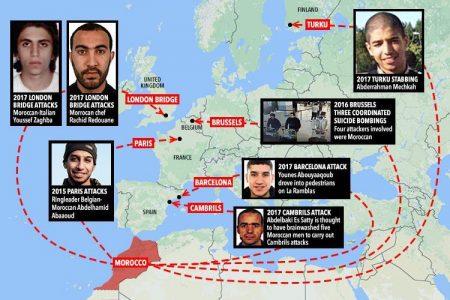
How twisted ISIS fanatics from Morocco have been behind terror attacks in EU
Barcelona terror suspect Younes Abouyaaqoub, 22, who was shot dead by cops last week, is thought to be the driver in the van attack on Spanish tourist hotspot Las Ramblas which killed 15 pedestrians.
He is just one of a number of suspected terrorists to have come from Morocco – a Muslim-majority nation considered as a main exporter of ISIS fighters to Syria.
Around 1,800 Moroccans have become jihadist fighters in Libya, Iraq and Syria in recent years, according Moroccan authorities.
Islamic State, which is losing territory, has claimed credit for a number of global attacks this year – although it has provided no evidence.
Some 1,000 jihadists are said to have been smuggled back to Morocco and Tunisia from the crumbling ISIS battlefields – where six of the 12 terrorists who carried out last week’s massacres in Spain are believed to have hailed, the Guardian reported.
With the fast-shrinking Islamic caliphate, Morocco is now seen as a springboard for attacks in Europe.
For decades, Spain has been the main destination for Moroccans who form 16.4 per cent of immigrants in Spain – making them the largest migrant community in the country.
The two countries nearly touch across the Strait of Gibraltar and Spain has two enclaves in North Africa separated from Morocco by barbed wire fences to stop illegal crossings.
Official figures show more than 3,300 migrants entered Spain illegally by sea from Morocco in the first four months of 2017.
This figure has tripled compared to just over a thousand in the same period in 2016, UN’s International Organisation for Migration reported.
As Spanish police piece together the perpetrators behind the Catalonia attacks, their anti-terrorism operation has focused on dozens of men of Moroccan origin.

Moroccan-born Moussa Oukabir, 18, was one of five jihadists shot dead in Cambrils after they drove in to a group of pedestrians on August 17, killing one woman and injuring six other people.
The 12-member cell is believed to be made up of brothers and childhood friends from Ripoll described as integrated, well-liked and responsible members of their tight-knit community.
But it is not the first time radicalised Moroccan youths living in Europe have been at the centre of terror attacks.
Just days later, the the main suspect in a knife attack in Finland’s Turku that killed two women was named as 18-year-old Moroccan asylum seeker Abderrahman Mechkah.
Two of the three men who carried out the London Bridge massacre on June 3 were from the North African nation – chef Rachid Redouane, 30, and 22-year-old Italian national Youssef Zaghba.
They wore fake suicide vests and drove a van into pedestrians before stabbing people in the busy Borough Market killing seven people.
Moroccan men were also involved in the Paris attacks in November 2015 and the Brussels airport bombings four months later which claimed the lives of 32 people.
Belgian-Moroccan Islamic terrorist Abdelhamid Abaaoud was the ringleader of the Paris attacks while Moroccan brothers Salah and Ibrahim Abdeslam carried out the attacks.
Mohamed Abrini, who was dubbed the “man in the hat” accompanied two suicide bombers in the Brussels airport attack.
He was caught on CCTV with Moroccan brothers Ibrahim and Khalid el-Bakraoui moments before the suicide bombing.
Belgian-Moroccan Najim Laachraoui, the bomb maker involved in the brutal terrorist attacks on Brussels also assembled the suicide vests for two of the terrorists who carried out the Paris atrocity in 2015.
The perpetrators reportedly had connections to the Middle East-based jihadism. Laachraoui, for example, is known to have travelled in Syria in 2013 where he worked as an ISIS prison guard.
Source: thesun






You must be logged in to post a comment.